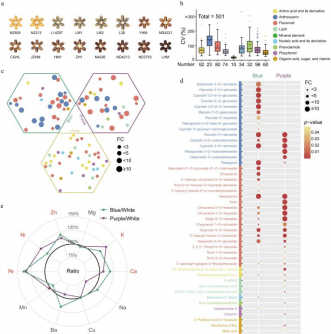URGENT UPDATE: Groundbreaking research from Huazhong Agricultural University reveals that colored wheat varieties contain an astonishing 501 essential nutrients, significantly surpassing traditional white wheat. This study, published on March 7, 2025, highlights the urgent need to address global nutritional deficiencies as dietary trends shift from “eating full” to “eating well.”
The research team, led by Wei Chen, conducted comprehensive analyses on blue, purple, and white wheat grains, discovering that colored wheat is particularly rich in health-promoting compounds such as anthocyanins, flavonoids, and essential minerals like iron and zinc. These findings are crucial as they indicate that colored wheat could be a key player in combating “hidden hunger” worldwide.
New insights from transcriptomic analysis identified important genes responsible for anthocyanin biosynthesis, opening avenues for breeding wheat varieties with enhanced nutritional profiles. The analysis revealed that green wheat kernels harvested during the mid-filling phase were exceptionally nutrient-dense, showing higher levels of beneficial compounds compared to mature grains.
The implications of this research are significant. With increasing rates of lifestyle-related health issues, such as diabetes and cardiovascular diseases, the antioxidant-rich profiles of colored wheat offer potential health benefits to consumers. The study underscores the need for immediate applications in agriculture and the functional food industry, as nutrient-dense whole grain products and health snacks become more vital.
Researchers found that blue wheat varieties were particularly abundant in glycosylated anthocyanins while purple wheat had higher acylated anthocyanins, explaining their vibrant pigmentation. Notably, analyses also confirmed that nutrient levels peaked during the early grain filling stages but declined as the grains matured, emphasizing the importance of harvest timing for maximizing nutritional content.
As global dietary needs evolve, the findings from this study could revolutionize how staple crops are bred and consumed. The identified genes and transcription factors provide critical markers for selecting varieties with superior nutritional qualities, paving the way for biofortification efforts aimed at enhancing food security.
This research is a vital step towards improving public health through better nutrition. As the world grapples with food systems under strain, colored wheat emerges as a promising solution to improve the nutritional landscape and combat nutrient deficiencies.
Stay tuned for more updates on this developing story, as the agricultural and health sectors watch closely for implications of these findings on food production and dietary guidelines.
For more detailed information, the full research can be accessed at the following link: Seed Biology (DOI: 10.48130/seedbio-0025-0003).
